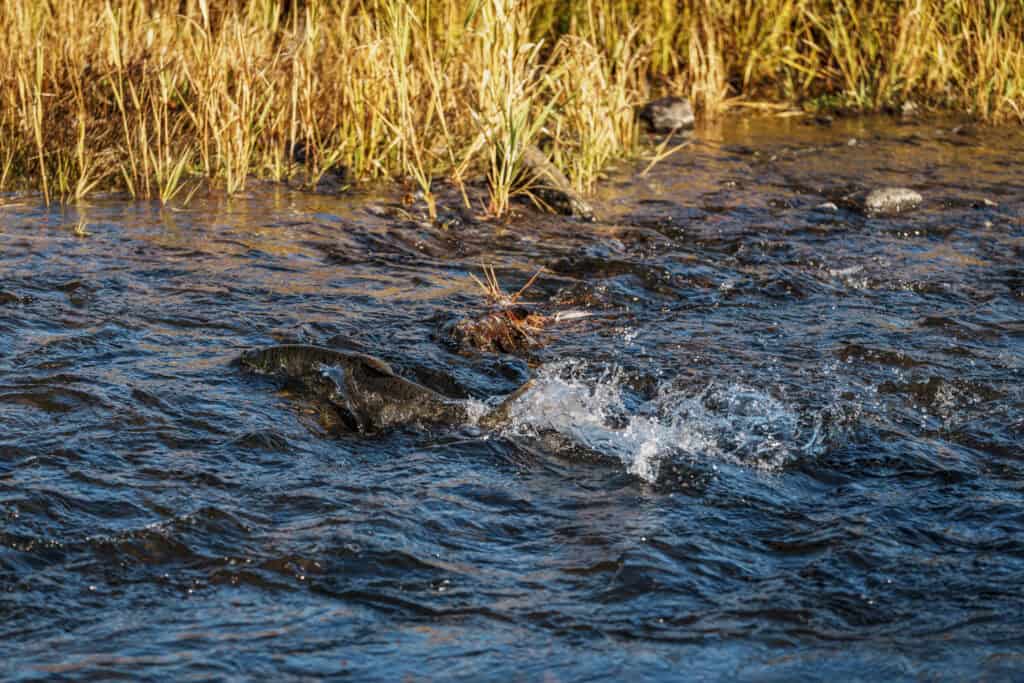Students Witness History: Field Trip Highlights Historic Return of Klamath Salmon

Contact: Josa Talley, Save California Salmon, (707) 672-9866, josa@californiasalmon.org
Regina Chichizola, Save California Salmon, 541 951-0126
Hornbrook, California- Months after the historic removal of four hydroelectric dams along the Klamath River, the region is witnessing remarkable ecological recovery and renewed community engagement, creating opportunities to use the river as a living classroom. Last week Humboldt and Siskiyou County schools embarked on their third year of dam removal field trips, where students observed salmon spawning where the Klamath dams once stood. Last spring these students watched the beginning of the dam removal process.
“It has been an emotional and exciting time to not only witness the dam removal but also to provide the community and youth the opportunity to see what can be accomplished with hard work and dedication,” shared Star Gibbens, SCS Youth Coordinator and local parent. “Watching the kids’ faces change from sadness at the dam site in previous years to excitement as they watched salmon spawn above the former dam sites will forever be a fond memory.”

Photo by Paul WIlson
The field trips are part of a collaborative effort involving the Karuk Tribe, Save California Salmon (SCS), the Mid Klamath Watershed Council (MKWK), schools within Siskiyou County and the Klamath-Trinity school district. Hundreds of middle school and high school students living along the Klamath River have learned about the dam removal process and participated in restoration efforts such as planting seeds. This fall students witnessed the first salmon return to spawn in Jenny Creek, upstream of the former Iron Gate dam site. They counted over 40 salmon.
“They said it was going to take 10 years for the salmon to return to the Upper Basin,” stated Karuk Tribe Vice Chairman, Kenneth Brink. “Once the dams were out, it took 10 days.”
The Klamath River Renewal Corporation (KRRC), and Resource Environment Solutions, the restoration contractor, has been supportive of efforts to involve students and families along the river in dam removal and restoration.
“We are so grateful for the support of SCS, MKWC, and the Karuk Tribe for pulling these field trips together,” said Ren Brownell from the KRRC. “The field trips allowed students to understand why dam removal was happening, see the changes happening on their river, and participate in the restoration. I hope they take away the lesson that fixing things isn’t always easy, but it is possible and worth the effort.”
Field trips to the newly restored river have become a favorite activity for river youth, allowing students to see firsthand the impact of environmental restoration. The groups involved have worked with schools, such as Orleans Elementary, to integrate the restoration into their science and social studies curricula, using the river as a platform to teach about ecosystems, water quality, and local Tribal culture. Some of these lessons are now available for free online and can be found at: https://savecaliforniasalmonteachersre.godaddysites.com/our-curricula
“My class is filled with students whose ancestors are the original stewards of the Klamath River, whose direct relatives are current stewards, and they themselves are the future stewards,” explained Clarissa Readen, an Orleans Elementary teacher and Yurok tribal member. “I am so grateful we were able to see the dams before they were taken down and the results after. They have seen their parents and community members fight for dam removal their entire lives, and it’s such a full-circle moment for them to witness this historic event. Seeing the salmon spawn in ‘their sacred spawning grounds,’ as one of my students put it, for the first time in 100 years, is as important as any curriculum in the classroom.”
Dam removal has united the community in celebration and action. Local residents, businesses, and Tribal leaders are collaborating on habitat restoration projects and recreational initiatives. Efforts like these are strengthening ties between people and the environment. Some students participating in the field trips are eager to further engage in river-related work and activism. Some are involved in Paddle Tribal Waters, which plans to make the first descent of the undammed Klamath in kayaks.
Wally Marshall, a 13 year old Karuk Tribal member from Junction Elementary is one of these students. “I went to the Iron Gate dam, but this time there was no dam. It was really amazing to see that the river wasn’t being held back anymore. The last time I went, there was no reservoir. This time we also saw a bunch of fish spawning that had come back after 100 years of being trapped—I thought that was incredible.”
Along with teaching about dam removal, Tribes and groups want to give the community a chance to celebrate. A key highlight is the upcoming Dam Removal Celebration on December 7th at the Arcata Theater Lounge in Arcata, California.
“Our local Tribes, communities and families worked for decades to get to the point.” explained Regina Chichizola, from SCS. “It took so many of us, and all of our skills, to bring the salmon home. It is time to not only heal our communities and work towards restoration, but also to celebrate this accomplishment.”
Tickets for the Arcata event are available at tinyurl.com/DamRemovalCelebration-Tickets.
As the Klamath River continues to heal, community members are invited to participate in upcoming events, volunteer opportunities, and educational programs. More information is at: www.californiasalmon.org/ or on Facebook (Save California Salmon) or Instagram (@californiarives).








